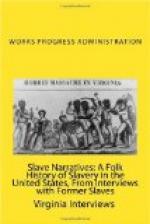“Chillun never had no wuk to do. Dey jus’ et and frolicked around gittin’ into evvything dey could find. Dey never got no lickin’s ’less dey was mighty bad, ’cause our Marster said he warn’t gwine to ’low no beatin’ on his Niggers ’cept what he done his own self, and dat was pow’ful little. In hot weather chillun played on de crick and de best game of all was to play lak it was big meetin’ time. White chillun loved to play dar too wid de little slave chillun. Us would have make-believe preachin’ and baptizin’ and de way us would sing was a sight. One of dem songs us chillun loved de best went lak dis:
’Why does you thirst
By de livin’ stream?
And den pine away
And den go to die.
’Why does you search
For all dese earthly things?
When you all can
Drink at de livin’ spring,
And den can live.’
“When us started playin’ lak us was baptizin’ ’em, us th’owed all us could ketch right in de crick, clothes and all, and ducked ’em. Whilst us was doin’ dat, us was singin’:
’Git on board, git on board
For de land of many mansions,
Same old train dat carried
My Mammy to de Promised Land.’
“One day our Marster hid in de trees and watched us ’cause Mist’ess had done been fussin’ down ‘bout chillun all comin’ in soaked to de hide. He waited ’til he seed all de preachin’ and baptizin’, den he hollered for us to stop and he tuk de ones what was doin’ all de baptizin’ and made ’em pray and sing, den he ducked ’em good in de water and made us all go up to de house to show Mist’ess how come so many of dem pore chillun had done been gittin’ wet so much. Us got a tannin’ den dat Marster ‘lowed would help us to git sho’ ’nough ’ligion.
“De wooden bowls what slave chillun et out of was made out of sweetgum trees. Us et wid mussel shells ’stid of spoons. Dem mussel shells was all right. Us could use ’em to git up plenty of bread and milk, or cornpone soaked wid peas and pot likker. Dey never let chillun have no meat ’til dey was big enough to wuk in de fields. Us had biscuit once a week, dat was Sunday breakfast, and dem biscuits was cakebread to us. De fust bought meat us chillun ever seed was a slab of side-meat Daddy got from de sto’ atter us had done left de plantation, and us was skeered to eat it ’cause it warn’t lak what us had been used to.
“Chillun jus’ wore one piece of clothes in summertime and dey all went bar’foots. De gals’ summer gyarment was a plain, sleeveless apron dress, and de boys wore skimpy little shirts and nothin’ else. Dey mixed cow-hair wid de cotton when dey wove de cloth to make our winter clothes out of, and I’m a-tellin’ you Missy, dat cow-hair cloth sho’ could scratch, but it was good and warm and Marster seed to it dat us had all de clothes us needed. De ’omans made all de cloth used on de place; dey cyarded, spun, and den wove it. Mammy was de weaver; dat was all she done, jus’ wove cloth. Dey dyed it wid red mud and ink balls, and sich lak.




